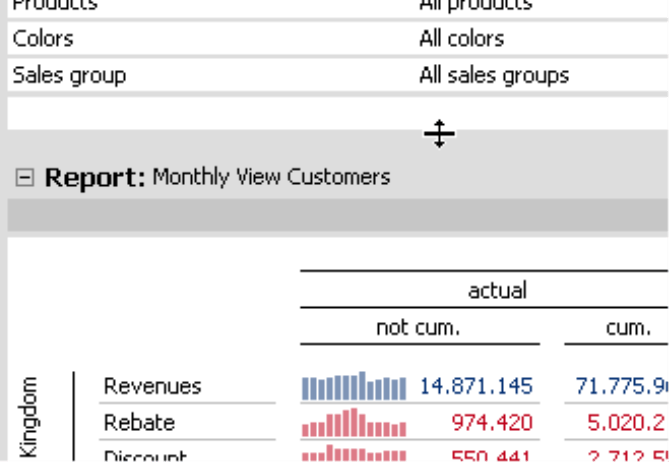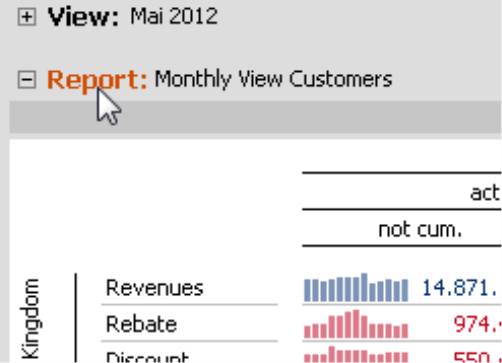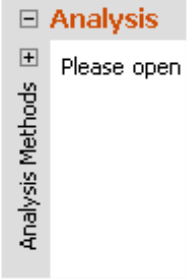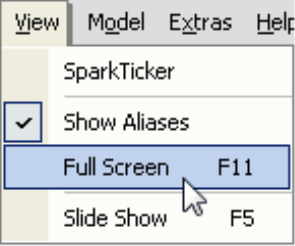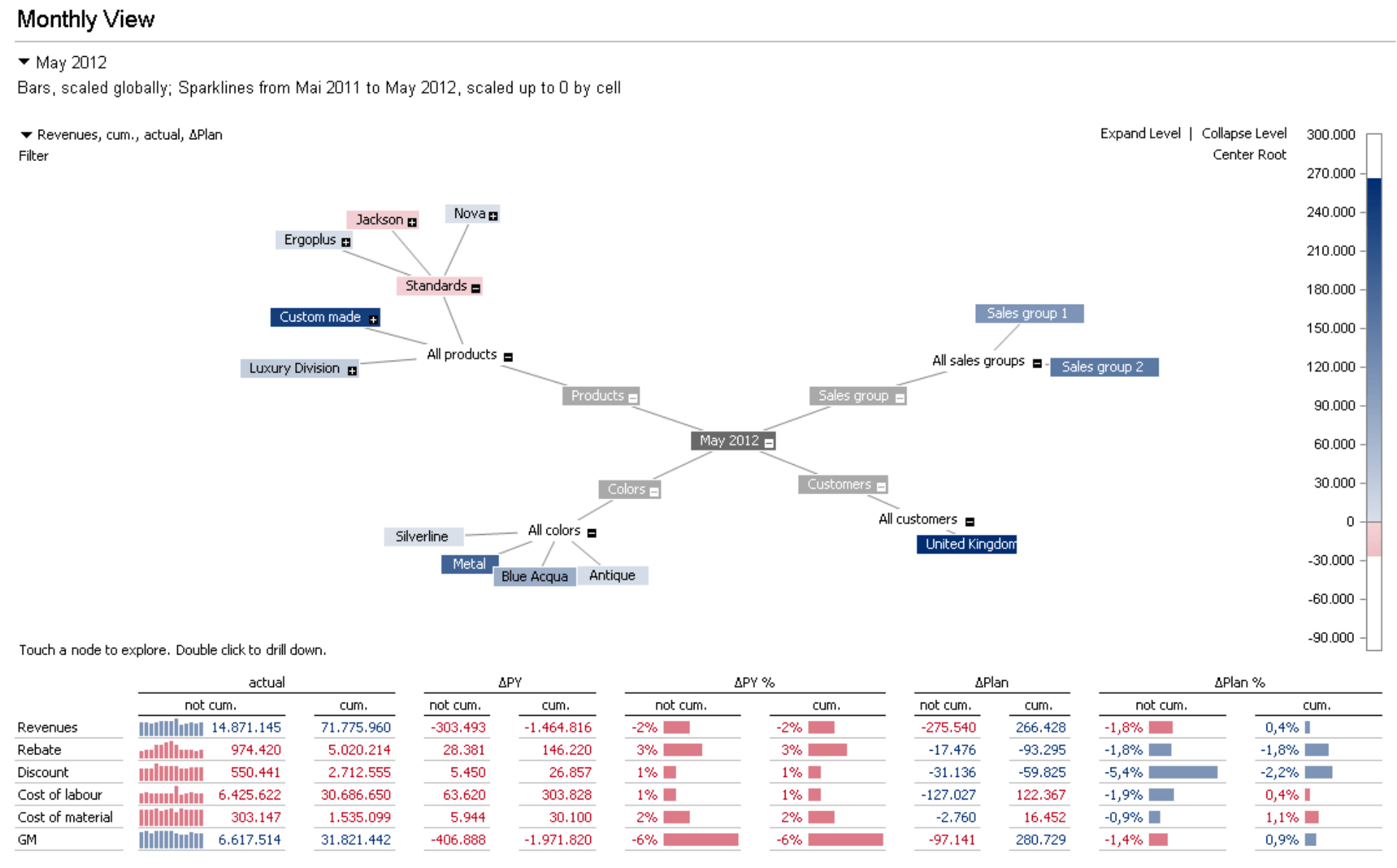Greetings, fellow data analysts!
When international trade fairs for information technology and consumer electronics rave about new computer screen sizes, those of us who travel to Pixelland on business want to shout, too – in disgust. Modern computer screens are wider but not really higher than the standard formats of past years. Wider screens might be nice for watching movies. To study management information, however, we need more room vertically.
Regardless of width or height, we need space…to work. And space is notoriously limited on computer screens. As a DeltaMaster user, you know all about the benefits of highly dense visualizations in reports and cockpits. Not to mention, its interface is easy to use even without huge buttons and colorful icons. But did you know that you can save even more pixels on your workspace by changing a few settings? We’ll show you how in this compact edition of clicks!.
Best regards,
Your Bissantz & Company team
In this edition of clicks!, we will take you on a little tour of DeltaMaster and offer tips on how you can adjust the user interface to make even more room for your analyses and reports.
Maximizing reports, cockpits, or analyses
DeltaMaster breaks down your screen into Report, Cockpit, and Analysis windows. As you already know, you can adjust their size by moving the gray dividers between the windows or expand and collapse them by clicking on the plus or minus signs. What you might not know, however, is that you can maximize a window with a simple double click. Most times, this is faster and easier than moving the dividers or collapsing windows. Try it and see for yourself:
If you double click on the window name in bold type (e.g. the word “Report”, “Analysis”, or “Cockpit”), DeltaMaster will maximize this window (or restore it to its previous size if it is already at its maximum). In doing so, DeltaMaster will automatically adjust all of the other windows and collapse them if necessary.
Restoring the expand/collapse status of windows
When you open an analysis session, DeltaMaster can automatically expand or collapse the windows of an analysis session to reflect how the windows were when you ended the last session. In Miner mode, for example, you could keep the Briefing book/History, View, and Analysis windows closed at the beginning of a session so that you only see the Cockpit window.
You can activate the Restore the expand state of windows switch in the Extras menu under Options on the General tab. At the end of each session, this expand state is saved for each user in the Windows registry. As a result, it applies to all analysis files that you edit on a given computer. If a start report has been defined in an analysis session, DeltaMaster will open the Briefing book to show where this start report is located. This setting overrides the saved status according to which the Briefing book should be collapsed.
Selecting the proper mode
Speaking of windows, the user interface in Miner mode is divided into three windows (aside from the Briefing book and History), namely View, Cockpit, and Analysis. Since Pivotizer only has two (i.e. View and Report), its interface is sleeker and requires less space.
Users who generally work in Miner mode, therefore, may want to switch to Pivotizer if they are working with pivot tables and do not need to use advanced analytic methods. Some users even find Pivotizer mode more comfortable to use because they can directly work with reports in the Briefing book instead of cockpits that they need to save as a report. And since DeltaMaster automatically generates the respective cockpits behind the scenes in Pivotizer mode, they can still see them when they switch back into Miner mode.
Showing a dimension list across multiple columns in the View window
Vertical space is limited on a computer screen. That’s why DeltaMaster offers a Show dimension list in multiple columns option in the context menu of the View window and the I want to… menu.
DeltaMaster automatically determines the number of columns by placing as many of them next to each other so that no vertical scrollbars are necessary. If you want to add more height to the View window, DeltaMaster will move the dimensions to the left and remove any columns that are no longer needed. If you reduce the height of the View window on the other hand, DeltaMaster will move the dimensions to the right and “wrap” them in new columns as needed.
DeltaMaster saves the setting for displaying dimension lists across multiple columns in the analysis (.das) file.
Collapsing the mode bar
You can also collapse the menu bar for switching among the different user modes (e.g. Reader, Viewer). In this case, DeltaMaster stores it as a small vertical bar on the left-hand side of the screen instead of as a horizontal bar that runs across the entire width of the application window.
If this menu bar is collapsed, you can still switch to a different user mode by clicking on its respective name.
When the mode bar is expanded, DeltaMaster offers pages for the Portal, Session, Web browser as well as Plug-ins such as ReportServer or the Repository on the right-hand corner of the horizontal menu. If you collapse the mode bar to a vertical position, however, these pages will be displayed in the bottom-right corner of the status menu in the application.
To collapse the menu, simply click on the minus sign in the upper-left corner of the mode bar. This symbol will appear as soon as you mouse over the menu bar. To restore the bar to its standard horizontal position, simply click on the plus sign above Miner.
You can save even more time with a double click. To collapse the horizontal menu bar, simply click twice on the white area outside of the labels. Conversely, you can expand a vertical menu bar by double clicking on the gray area below the names of the user modes.
Expanding/Collapsing an analysis menu
Similar to the user mode bar, you can also expand or collapse the analysis menu in Miner mode. If this menu is collapsed, DeltaMaster will display it as a small vertical bar on the left-hand corner instead of as a column in the Analysis window. This bar will display the analysis method that is currently active.
Simply click on the minus sign in the upper part of the analysis menu to collapse the menu or on the plus sign to restore it. Alternatively, you can also double click on the “Analysis” menu label or the name of the active analysis method to switch between a horizontal and vertical bar position.
Full-screen mode
Another way to obtain more space in DeltaMaster is to work in Full-screen mode (not to be confused with presentation mode), which utilizes all of the available room on the screen. Full-screen mode saves even more space than maximizing all of the application windows because it removes three typical Windows elements:
- The Windows taskbar
- The title menu which displays the program name (i.e. “DeltaMaster”) and the file name of the opened analysis session
- The status bar which displays context-sensitive help content on menu entries, etc.
You can activate or deactivate Full-screen mode from the View menu or by hitting the F11 key, as you may know from other Windows applications.
Presentation mode
You can also start the Presentation mode by clicking the respective option in the View menu or hitting the F5 key. If you press Shift+F5, DeltaMaster will even open the current report (instead of the start report or the first folder) in this mode. This feature is unique because it uses an automatically generated layout which is specially designed for interactive screen presentations, meetings, and similar situations. You can also use it, however, if you want to examine your own reports in more detail by yourself. For more information about the presentation mode, please read DeltaMaster clicks! 09/2009.
In the presentation mode, you can also change the view of a report, for example, to show the previous month or a different sales region just as you can in Viewer mode. Starting in DeltaMaster 5.5.3, you can also display the Hyperbrowser in the presentation mode as shown in the screenshot above provided that you are working in Miner or have a separate Hyperbrowser license for other user modes.
Questions? Comments?
Just contact your Bissantz team for more information.
